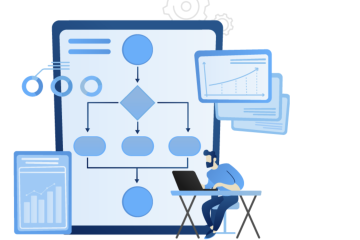
January 17, 2024
Each device linked to a network, whether it’s a PC, laptop, smartphone, or another type, represents a potential vulnerability for hackers. Typically, these devices serve as the initial target for cybercriminals attempting to breach a system. Should a vulnerability be identified, the intruder gains unauthorized access to an otherwise well-protected network without the need to bypass its primary cyber defenses.
What is Endpoint Security?
Endpoint security refers to the approach and set of practices designed to safeguard the various devices (endpoints) connected to a network, such as computers, laptops, smartphones, and servers. The primary goal of endpoint security is to protect these devices from potential cybersecurity threats, including malware, unauthorized access, data breaches, and other malicious activities.
Endpoint security involves deploying a combination of software, hardware, and network security measures to ensure the security of individual devices and the overall network. Common components of endpoint security include antivirus software, firewalls, intrusion detection and prevention systems, encryption tools, and security policies.
With the increasing number of devices connected to networks and the growing sophistication of cyber threats, endpoint security has become a critical aspect of overall cybersecurity strategies for organizations and individuals alike. It helps prevent, detect, and respond to potential security incidents that may originate from or target endpoints within a network.
What are the main types of Endpoint Security
There are several types of endpoint security solutions, each addressing different aspects of security. Here are the main types:
- Antivirus/Anti-malware
Functionality: Antivirus or anti-malware software is designed to detect, prevent, and remove malicious software, such as viruses, worms, Trojans, and other types of malware.
How it works: It uses a combination of signature-based detection (matching known patterns of malicious code) and heuristic analysis (identifying new or modified threats based on behavior) to identify and eliminate threats.
- Firewall
Functionality: A firewall is a network security device that monitors and controls incoming and outgoing network traffic based on predetermined security rules. It can be implemented at both the hardware and software levels.
How it works: Firewalls inspect network packets and determine whether to allow or block them based on established rules. They help prevent unauthorized access to the network and protect against various cyber attacks.
- Endpoint Detection and Response (EDR)
Functionality: EDR solutions focus on detecting and responding to advanced threats and targeted attacks on endpoints. They provide real-time monitoring, analysis, and response capabilities to security incidents.
How it works: EDR solutions continuously collect and analyze endpoint data, looking for abnormal behavior or signs of compromise. They enable security teams to respond quickly to incidents, investigate threats, and implement necessary countermeasures.
- Data Loss Prevention (DLP)
Functionality: DLP solutions are designed to prevent unauthorized access, use, or disclosure of sensitive data. They monitor and control data transfers, both within the organization’s network and to external sources.
How it works: DLP tools use content inspection and contextual analysis to identify and protect sensitive information. They can enforce policies to prevent data leakage and provide alerts or block actions that violate established rules.
- Endpoint Encryption
Functionality: Endpoint encryption safeguards data on devices by encrypting the information stored on them. It protects against unauthorized access, especially in the case of lost or stolen devices.
How it works: Encryption algorithms are applied to data, making it unreadable without the appropriate decryption key. This ensures that even if a device is compromised, the data remains secure.
- Patch Management
Functionality: Patch management is the process of identifying, acquiring, testing, and applying patches (software updates) to systems and applications to address vulnerabilities and improve security.
How it works: Organizations regularly update software and applications to fix known security flaws. Patch management ensures that endpoints are up-to-date with the latest security patches to minimize the risk of exploitation.
- Application Control
Functionality: Application control, or whitelisting, allows organizations to control which applications are allowed to run on endpoints. It helps prevent the execution of malicious or unauthorized software.
How it works: Organizations define a whitelist of approved applications, and the endpoint security solution enforces these restrictions. Any attempt to run an application not on the whitelist is blocked.
- Behavioral Analysis
Functionality: Behavioral analysis solutions focus on monitoring the behavior of applications and processes on endpoints to identify and block abnormal or malicious activities.
How it works: By establishing a baseline of normal behavior, these solutions can detect deviations that may indicate a security threat. Behavioral analysis adds an extra layer of protection against unknown or zero-day threats.
Implementing a combination of these endpoint security measures is often recommended to create a robust defense against a wide range of cyber threats. The integration of these technologies helps organizations establish a multi-layered security approach, enhancing overall protection for their endpoints and network.
Future of Endpoint Security
The future of endpoint security is poised for significant advancements driven by emerging technologies and evolving cyber threats. A notable trend is the widespread adoption of the Zero Trust security model, which challenges the assumption that devices and users within a network can be inherently trusted. Endpoint security will increasingly implement continuous verification and authentication, bolstering defenses against internal and external threats. Artificial intelligence (AI) and machine learning (ML) will play pivotal roles in enhancing detection and response capabilities, enabling security solutions to better identify and mitigate sophisticated or previously unknown threats. The rise of Extended Detection and Response (XDR) solutions will integrate data from various security tools, providing a more comprehensive view of security incidents. Cloud-native endpoint security is expected to gain prominence, offering scalability, real-time updates, and efficient analysis of large datasets in the cloud. As the Internet of Things (IoT) continues to grow, endpoint security will need to integrate robust measures to secure connected devices. Moreover, an identity-centric security approach will become increasingly crucial, emphasizing the importance of effective identity and access management in overall endpoint protection. Overall, the future landscape of endpoint security will be shaped by a holistic and adaptive approach to counter the dynamic nature of cyber threats.
Author’s Bio:
With Ciente, business leaders stay abreast of tech news and market insights that help them level up now,
Technology spending is increasing, but so is buyer’s remorse. We are here to change that. Founded on truth, accuracy, and tech prowess, Ciente is your go-to periodical for effective decision-making.
Our comprehensive editorial coverage, market analysis, and tech insights empower you to make smarter decisions to fuel growth and innovation across your enterprise.
Let us help you navigate the rapidly evolving world of technology and turn it to your advantage.





